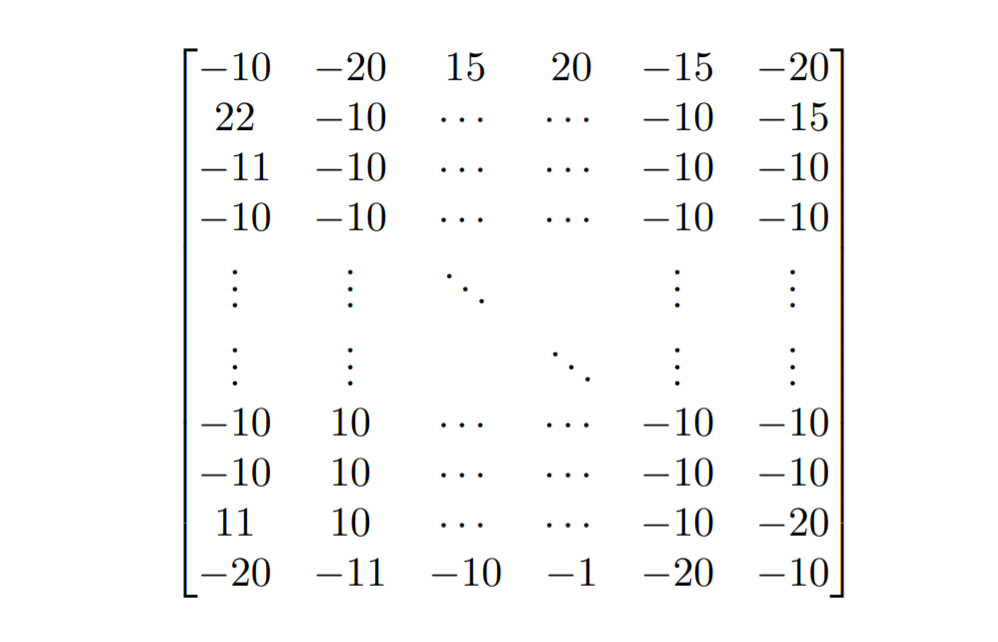Mathematical equations and textual contents sometimes contain a row of dots (\( \cdots\)). These dots’ meaning together is “ and so on”. These three dots refer to ellipsis points. Ellipses are exactly three dots, not less or more. In LaTeX, if you would only type a period (.) three times in a row, it will generate undesirable results such as… , In the output, those dots are too close together. In this post, we will present different types of ellipses and how they are generated in LaTeX. Examples are from math mode and text mode to master inserting ellipses in LaTeX.
Types of Ellipsis Pointers in LaTeX
LaTeX provides several commands to space the Ellipses correctly:
| Ellipsis | LaTeX command | Output |
|---|---|---|
| Low 3 dots | \ldots | \(\ldots \) |
| Center 3 dots | \cdots | \(\cdots \) |
| Vertical 3 dots | \vdots | \(\vdots \) |
| Diagonal 3 dots | \ddots | \(\ddots \) |
The difference between the \ldots and \cdots macro of the above table is illustrated by the following examples:
% Example of low and center ellipses
\documentclass{article}
\usepackage{amsmath}
\begin{document}
A low ellipsis: $x_1, x_2,\ldots, x_p$
A centered ellipsis: $a_1 a_2 \cdots a_n$
\end{document}
Compiling this code yields:

The command \ldots is usable both in text and math mode; the remaining three kinds of ellipsis are only allowed in math mode.
Usually, low ellipsis \ldots are used between letters and commas. On the contrary, in mathematical equations, it is a common practice of using the centered ellipsis (especially between operators, operations, and relational symbols). The matrix may use vertical ellipses, sometimes diagonal ellipses.
LaTeX Ellipsis in Text Mode
In textual mode, you can use \ldots command to implement three sequential dots with a wider spacing. These three dots of ellipsis could refer a short interval, unfinished impression, or missing words. When users only accumulate dots, these are printed out tightly together. However, it is wise and appropriate to implement these dots broader. In the text mode, both \dots and \ldots have the same effect.
% Example of \ldots (\dots) in text mode
\documentclass{article}
\usepackage{amsmath}
\begin{document}
These tornadoes made of wind and fire occur during a wildfire. Their flaming towers can be five to ten stories tall and can be last for \ldots fire devils.
These tornadoes made of wind and fire occur during a wildfire. Their flaming towers can be five to ten stories tall and can be last for \dots fire devils.
\end{document}
Compiling this code yields:

Ellipsis in Mathematical Formulas
Recall that, in standard LaTeX, you have the commands \ldots and \cdots for printing ellipses points, either on the baseline or raised to the center of the line. \vdots and \ddots are used to place three dots in a vertical and diagonal positions, respectively.
The following example highlight the use of ellipses in a matrix to denote the repetition of a number (-10 in this case).
% LaTeX Ellipsis in a matrix
\documentclass{article}
\usepackage{amsmath}
\begin{document}
\[
\begin{bmatrix}
-10 & -20 & 15 & 20 & -15 & -20 \\
22 & -10 & \cdots & \cdots & -10 & -15 \\
-11 & -10 & \cdots & \cdots & -10 & -10 \\
-10 & -10 & \cdots & \cdots & -10 & -10 \\
\vdots & \vdots & \ddots & & \vdots & \vdots \\
\vdots & \vdots & & \ddots & \vdots & \vdots \\
-10 & 10 & \cdots & \cdots & -10 & -10 \\
-10 & 10 & \cdots & \cdots & -10 & -10 \\
11 & 10 & \cdots & \cdots & -10 & -20 \\
-20 & -11 & -10 & -1 & -20 & -10
\end{bmatrix}
\]
\end{document}
Compiling this code yields:

Conclusion
In this post, we presented different LaTeX commands of ellipses and their use in text and math mode. This includes baseline, center, vertical and diagonal ellipses.